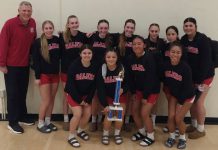Some say it’s a numbers game, others point to coaching, either
way the Acorns have a history of success
They dominate in aquatic sports. They dominate in soccer,
baseball and softball, and even on the football field.
Just look at the countless league titles and playoff appearances
during the past 30 years and it quickly becomes apparent that Live
Oak High School in Morgan Hill has had one of the most successful
athletic programs in the Central Coast Section
– especially when compared to other public schools.
This September the school that has made winning league titles in
a number of sports an annual formality, will leave the Tri County
Athletic League to compete in the Blossom Valley Athletic League in
San Jose.
Some say it’s a numbers game, others point to coaching, either way the Acorns have a history of success
They dominate in aquatic sports. They dominate in soccer, baseball and softball, and even on the football field.
Just look at the countless league titles and playoff appearances during the past 30 years and it quickly becomes apparent that Live Oak High School in Morgan Hill has had one of the most successful athletic programs in the Central Coast Section – especially when compared to other public schools.
This September the school that has made winning league titles in a number of sports an annual formality, will leave the Tri County Athletic League to compete in the Blossom Valley Athletic League in San Jose.
The move was decided on a few years ago by the Morgan Hill Unified School District and administrators after a number of concerns were voiced. One of them was that the perennial powerhouse Acorns would not be able to successfully compete in the TCAL as a result of the school’s dwindling student body population, which has gone from pushing the 3,000 mark just a decade ago to now hovering at 1,400 since the opening of Ann Sobrato High School two years ago.
All of this has occurred while Gilroy, Salinas and San Benito High’s population numbers continue to grow towards the 3,000 mark.
While this all may be true, surprisingly, Sobrato’s opening two years ago has not affected Live Oak’s success on the playing field, despite the fact that coaches at Live Oak now have a far smaller talent pool from which to recruit.
During the past year alone, the Acorns won a CCS title in softball, won the league title in baseball and picked up league titles in both boys’ and girls’ swimming, water polo and soccer, and even claimed stake as co-champions of the league in football this past fall.
So the question is why are the sports teams at Live Oak so successful year in and year out?
“Basically, you need three things to be successful,” said Norm Dow, the associated student body director at Live Oak who led the Acorns to four CCS and 10 league titles during his 17-year stint as the school’s head varsity football coach that began in 1980. “The first is good coaching. Another is having the athletes that are willing to pay the price and work hard. They don’t have to be great athletes, but they have to be hard working. And lastly is to have the support of the administration and community. They are the three most valuable things.”
While most coaches agree that those are key factors in the overall equation for success, another was Morgan Hill’s proximity to San Jose.
As San Jose grew and home prices in the Bay Area soared more younger families moved to the more affordable Morgan Hill area. The result was a growing student body population that grew from the 1970s to the mid 1990s.
“Our success has really been a combination of factors,” said Live Oak water polo coach Mac Haines, who has lead the Acorns to 18 league titles. “I got here 20 years ago. It was much like the demographic situation is now in Hollister. We were the bedroom community for San Jose. Now it’s that way in Hollister. The young people used to move to Morgan Hill and that changed about 10 years ago as many people realized they could move to Hollister to get a bigger house for less money. And they were willing to make a larger commute for it.
“The other part of that is that we were a one high-school town. And even though we were a commuter town, there has always been a strong sense of community here,” Haines said.
While Haines makes valid points, Gilroy High’s student body population grew for the same reasons yet the Mustangs have not had the success that their counterparts from Morgan Hill have had during the years on the playing field.
“Obviously, success is a combination of coaching and kids. Like any other public school, you’ve got to play with who shows up,” said Gilroy High Athletic Director Jack Daley. “Any program that’s good has that combination. They also had a lot of kids. I think for a while [Live Oak’s] three grades were as big or close to our population with four grades.”
Up until three years ago, Live Oak only housed sophomores, juniors and seniors. Before that, ninth graders in the district attended Martin Murphy Middle School or Britton Middle School.
In addition to demographic reasons and the support of the community Haines points out that the high school has always had an administration that saw the value in athletics.
“When I first got here there was a guy named John Almond, who was the associated student body director, the vice principal in charge of athletics and he was also the principal at one time,” he said. “He was very big on sports and was real good at personnel. He hired a lot of fine teachers who were also very good coaches. A lot of them are still here today.”
According to Haines, Almond was instrumental in bringing in himself, varsity baseball coach Mark Cummins, former Olympic medallist Lynn (Vidali) Gautschi, who coached the swim team for many years and current football coaches Rick Booth and Glen Webb.
Haines also pointed out that longtime varsity football coach Norm Dow, who won four CCS titles in the 1980s, was a close friend with Almond, who was highly supportive of the football program.
“I remember when I first came here Norm Dow spent a lot of time with me just talking about the tradition here and the community. And even coaches that were leaving really made the effort to keep the tradition of winning going. When Mike Perez (former baseball coach) left here to go to West Valley, he recruited Mark Cummins. They wanted to make sure what was started was carried on.”
As the program was gaining recognition in the mid 1970s, former University of California, Berkeley basketball player Duane Aspland was also the school’s athletic director. His daughter was an Olympic swimmer and Aspland coached the varsity basketball team for many years.
Sobrato Athletic Director Dennis Martin held the same position at Live Oak and taught at the school for more than 30 years. He sees Live Oak’s athletic success as a numbers game.
“In the 1980s and 1990s we were the dominant school in the CCS in terms of the numbers of kids. We were always in the top five. I think Independence may have been No. 1 but we were always right there,” he said. “Back then we had about 2,800 kids. Hollister had about 1,800 and Gilroy was at about 2,000. It has been my assertion that typically you have one great athlete out of every 100 athletes. So back then we’d have close to 30 great athletes and the other schools might have half that many.”
But if it’s a numbers game, it doesn’t explain Live Oak’s dominance now.
“It hasn’t fully hurt us yet but it’s coming,” said Live Oak’s current Athletic Director Mark Cummins. “So far, we’ve been lucky.”
“We had a good year this past year but there is no doubt that splitting the school and opening Sobrato will hurt us,” Dow said. “(What’s helping us) is that there’s no turnover in coaching staffs. Haines has been here for years. Glen Webb and Rick Booth both worked for me.”
Most coaches agree with Dow, pointing out that the secret behind the Acorns ongoing success can be found in the continuity of the coaching staffs.
“I guess it’s really been the longevity and quality of the coaches here,” Haines said.
“Some of the same coaches have been there for years,” Martin said. “It’s huge to set up the programs and keep them going. The kids know what to expect coming in and the coaches do also. Everyone is on the same page. They got good coaches and people established.”
According to Cummins, the feeder programs at the lower levels also have to be credited with some of the successes that the high school’s varsity squads have enjoyed during the years.
“The coaches here have been given the opportunity to stay and build our programs, but the feeder programs also do well,” said Cummins, whose baseball teams have made the playoffs 17 of the last 19 years. “Pop Warner does well here and so does Orchard Valley Soccer and Morgan Hill Pony Baseball.”
Martin agrees.
“They’ve geared the youth sports here to the high school coaches philosophy for years,” said Martin. “Many of the kids already know the high school coaches before they get there so that they know what they want when they do.”
Cummins points out that many of the high schools to the north don’t have strong booster clubs – or any booster clubs at all.
“We get all kinds of community support down here,” said Cummins, who has coached the Acorns varsity baseball team to eight league titles. “When I talk to some of the coaches in San Jose about our booster clubs they kind of look at you funny because they often don’t even have one.
“When I came here in 1987 we had more of a small-town feeling and the Live Oak Acorns were the only game in town – the only team to get behind. As the city has grown we’ve grown away from that a bit but we still get great support.”









